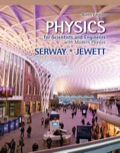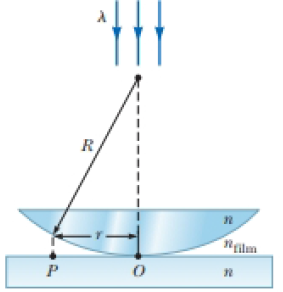Problem 37.1QQ: Which of the following causes the fringes in a two-slit interference pattern to move farther apart?... Problem 37.2QQ: Using Figure 36.6 as a model, sketch the interference pattern from six slits. Figure 36.6... Problem 37.3QQ: One microscope slide is placed on top of another with their left edges in contact and a human hair... Problem 37.1OQ: While using a Michelson interferometer (shown in Fig. 37.13), you see a dark circle at the center of... Problem 37.2OQ: Four trials of Young's double-slit experiment are conducted. (a) In the first trial, blue light... Problem 37.3OQ: Suppose Youngs double-slit experiment is performed in air using red light and then the apparatus is... Problem 37.4OQ: Green light has a wavelength of 500 nm in air. (i) Assume green light is reflected from a mirror... Problem 37.5OQ: A thin layer of oil (n = 1.25) is floating on water (n = 1.33). What is the minimum nonzero... Problem 37.6OQ: A monochromatic beam of light of wavelength .500 nm illuminates a double slit having a slit... Problem 37.7OQ: According to Table 35.1, the index of refraction of flint glass is 1.66 and the index of refraction... Problem 37.8OQ: Suppose you perform Youngs double-slit experiment with the slit separation slightly smaller than the... Problem 37.9OQ: A plane monochromatic light wave is incident on a double slit as illustrated in Figure 37.1. (i) As... Problem 37.10OQ: A film of' oil on a puddle in a parking lot shows a variety of bright colors in swirled patches.... Problem 37.1CQ Problem 37.2CQ Problem 37.3CQ: Explain why two flashlights held close together do not produce an interference pattern on a distant... Problem 37.4CQ: A lens with outer radius of curvature R and index of refraction n rests on a flat glass plate. The... Problem 37.5CQ: Consider a dark fringe in a double-slit interference pattern at which almost no light energy is... Problem 37.6CQ Problem 37.7CQ: What is the necessary condition on the path length difference between two waves that interfere (a)... Problem 37.8CQ: In a laboratory accident, you spill two liquids onto different parts of a water surface. Neither of... Problem 37.9CQ: A theatrical smoke machine fills the space bet barrier and the viewing screen in the Youngs d... Problem 37.1P: Two slits are separated by 0.320 mm. A beam of 500-nm light strikes the slits, producing an... Problem 37.2P: Light of wavelength 530 nm illuminates a pair of slits separated by 0.300 mm. If a screen is placed... Problem 37.3P: A laser beam is incident on two slits with a separation of 0.200 mm. and a screen is placed 5.00 m... Problem 37.4P: A Youngs interference experiment is performed with blue-green argon laser light. The separation... Problem 37.5P: Youngs double-slit experiment is performed with 589-inn light and a distance of 2.00 in between the... Problem 37.6P: Why is the following situation impossible? Two narrow slits are separated by 8.00 mm in a piece of... Problem 37.7P: Light of wavelength 620 nm falls on a double slit, and the first bright fringe of the interference... Problem 37.8P: In a Youngs double-slit experiment, two parallel slits with a slit separation of 0.100 mm are... Problem 37.9P: pair of narrow, parallel slits separated by 0.250 mm illuminated by green light ( = 546.1 nm). The... Problem 37.10P: Light with wavelength 442 nm passes through a double-slit system that has a slit separation d =... Problem 37.11P: The two speakers of a boom box are 35.0 cm apart. A single oscillator makes the speakers vibrate in... Problem 37.12P Problem 37.13P: Two radio antennas separated by d = 300 in as shown in Figure P37.13 simultaneously broadcast... Problem 37.14P: A riverside warehouse has several small doors facing the river. Two of these doors are open as shown... Problem 37.15P: A student holds a laser that emits light of wavelength 632.8 nm. The laser beam passes through a... Problem 37.16P: A student holds a laser that emits light of wavelength . The laser beam passes through a pair of... Problem 37.17P: Radio waves of wavelength 125 m from a galaxy reach a radio telescope by two separate paths as shown... Problem 37.18P: In Figure P36.10 (not to scale), let L = 1.20 m and d = 0.120 mm and assume the slit system is... Problem 37.19P: Coherent light rays of wavelength strike a pair of slits separated by distance d at an angle 1 with... Problem 37.20P: Monochromatic light of wavelength is incident on a pair of slits separated by 2.40 104 m and forms... Problem 37.21P: In the double-slit arrangement of Figure P36.13, d = 0.150 mm, L = 140 cm, = 643 nm. and y = 1.80... Problem 37.22P: Youngs double-slit experiment underlies the instrument landing system used to guide aircraft to sale... Problem 37.23P: Two slits are separated by 0.180 mm. An interference pattern is formed on a screen 80.0 cm away by... Problem 37.24P Problem 37.25P: In Figure P37.18, let L = 120 cm and d = 0.250 cm. 0T he slits are illuminated with coherent 600-nm... Problem 37.26P: Monochromatic coherent light of amplitude E0 and angular frequency passes through three parallel... Problem 37.27P: The intensity on the screen at a certain point in a double- slit interference pattern is 64.0% of... Problem 37.28P: Green light ( = 546 nm) illuminates a pair of narrow, parallel slits separated by 0.250 mm. Make a... Problem 37.29P: Two narrow, parallel slits separated by 0.850 mm are illuminated by 600-nm light, and the viewing... Problem 37.30P: A soap bubble (n = 1.33) floating in air has the shape of a spherical shell with a wall thickness of... Problem 37.31P: A thin film of oil (n = 1.25) is located on smooth, wet pavement. When viewed perpendicular to the... Problem 37.32P: A material having an index of refraction of 1.30 is used as an antireflective coating on a piece of... Problem 37.33P Problem 37.34P: A film of MgF2 (n = 1.38) having thickness 1.00 105 cm is used to coat a camera lens. (a) What are... Problem 37.35P: A beam of 580-nm light passes through two closely spaced glass plates at close to normal incidence... Problem 37.36P: An oil film (n = 1.45) floating on water is illuminated by white light at normal incidence. The film... Problem 37.37P: An air wedge is formed between two glass plates separated at one edge by a very fine wire of... Problem 37.38P: Astronomers observe the chromosphere of the Sun with a filter that passes the red hydrogen spectral... Problem 37.39P: When a liquid is introduced into the air space between the lens and the plate in a Newtons-rings... Problem 37.40P: A lens made of glass (ng = 1.52) is coated with a thin film of MgF2 (ns = 1.38) of thickness t.... Problem 37.41P: Two glass plates 10.0 cm long are in contact at one end and separated at the other end by a thread... Problem 37.42P: Mirror M1 in Figure 36.13 is moved through a displacement L. During this displacement, 250 fringe... Problem 37.43P Problem 37.44P: One leg of a Michelson interferometer contains an evacuated cylinder of length L, having glass... Problem 37.45AP: Radio transmitter A operating at 60.0 MHz is 10.0 m from another similar transmitter B that is 180... Problem 37.46AP: A room is 6.0 m long and 3.0 m wide. At the front of the room, along one of the 3.0-m-wide walls,... Problem 37.47AP: In an experiment similar to that of Example 36.1, green light with wavelength 560 nm, sent through a... Problem 37.48AP: In the What If? section of Example 36.2, it was claimed that overlapping fringes in a two-slit... Problem 37.49AP: An investigator finds a fiber at a crime scene that lie wishes to use as evidence against a suspect.... Problem 37.50AP: Raise your hand and hold it flat. Think of the space between your index finger and your middle... Problem 37.51AP: Two coherent waves, coming from sources at different locations, move along the x axis. Their wave... Problem 37.52AP: In a Youngs interference experiment, the two slits are separated by 0.150 mm and the incident light... Problem 37.53AP: In a Youngs double-slit experiment using light of wavelength , a thin piece of Plexiglas having... Problem 37.54AP: Review. A flat piece of glass is held stationary and horizontal above the highly polished, flat top... Problem 37.55AP: A certain grade of crude oil has an index of refraction of 1.25. A ship accidentally spills 1.00 m3... Problem 37.56AP: The waves from a radio station can reach a home receiver by two paths. One is a straight-line path... Problem 37.57AP: Interference effects are produced at point P on a screen as a result of direct rays from a M)0-nm... Problem 37.58AP: Measurements are made of the intensity distribution within the central bright fringe in a Youngs... Problem 37.59AP: Many cells are transparent anti colorless. Structures of great interest in biology and medicine can... Problem 37.60AP: Consider the double-slit arrangement shown in Figure P37.60, where the slit separation is d and the... Problem 37.61AP: Figure P36.35 shows a radio-wave transmitter and a receiver separated by a distance d = 50.0 m and... Problem 37.62AP: Figure P36.35 shows a radio-wave transmitter and a receiver separated by a distance d and both a... Problem 37.63AP: In a Newtons-rings experiment, a plano-convex glass (n = 1.52) lens having radius r = 5.00 cm is... Problem 37.64AP: Why is the following situation impossible? A piece of transparent material having an index of... Problem 37.65AP: A plano-concave lens having index of refraction 1.50 is placed on a flat glass plate as shown in... Problem 37.66AP: A plano-convex lens has index of refraction n. The curved side of the lens has radius of curvature R... Problem 37.67AP: Interference fringes are produced using Lloyds mirror and a source S of wavelength = 606 nm as... Problem 37.68AP Problem 37.69AP: Astronomers observe a 60.0-MHz radio source both directly and by reflection from the sea as shown in... Problem 37.70AP: Figure CQ37.2 shows an unbroken soap film in a circular frame. The film thickness increases from lop... Problem 37.71CP: Our discussion of the techniques for determining constructive and destructive interference by... Problem 37.72CP: The condition for constructive interference by reflection from a thin film in air as developed in... Problem 37.73CP: Both sides of a uniform film that has index of refraction n and thickness d are in contact with air.... Problem 37.74CP Problem 37.75CP: Monochromatic light of wavelength 620 nm passes through a very narrow slit S and then strikes a... Problem 37.76CP format_list_bulleted



 Physics for Scientists and EngineersPhysicsISBN:9781337553278Author:Raymond A. Serway, John W. JewettPublisher:Cengage Learning
Physics for Scientists and EngineersPhysicsISBN:9781337553278Author:Raymond A. Serway, John W. JewettPublisher:Cengage Learning Physics for Scientists and Engineers with Modern ...PhysicsISBN:9781337553292Author:Raymond A. Serway, John W. JewettPublisher:Cengage Learning
Physics for Scientists and Engineers with Modern ...PhysicsISBN:9781337553292Author:Raymond A. Serway, John W. JewettPublisher:Cengage Learning Physics for Scientists and Engineers, Technology ...PhysicsISBN:9781305116399Author:Raymond A. Serway, John W. JewettPublisher:Cengage Learning
Physics for Scientists and Engineers, Technology ...PhysicsISBN:9781305116399Author:Raymond A. Serway, John W. JewettPublisher:Cengage Learning Physics for Scientists and Engineers: Foundations...PhysicsISBN:9781133939146Author:Katz, Debora M.Publisher:Cengage Learning
Physics for Scientists and Engineers: Foundations...PhysicsISBN:9781133939146Author:Katz, Debora M.Publisher:Cengage Learning Principles of Physics: A Calculus-Based TextPhysicsISBN:9781133104261Author:Raymond A. Serway, John W. JewettPublisher:Cengage Learning
Principles of Physics: A Calculus-Based TextPhysicsISBN:9781133104261Author:Raymond A. Serway, John W. JewettPublisher:Cengage Learning College PhysicsPhysicsISBN:9781305952300Author:Raymond A. Serway, Chris VuillePublisher:Cengage Learning
College PhysicsPhysicsISBN:9781305952300Author:Raymond A. Serway, Chris VuillePublisher:Cengage Learning




